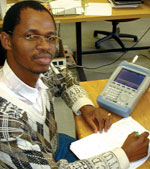Stellenbosch student presents paper on SA satellite at conference
4 October 2006
Telecoms, Datacoms, Wireless, IoT
A post-graduate student at the University of Stellenbosch represented South Africa at the Utah Small Satellite Conference that was held in the USA in August.
Kgabo Mathapo presented a paper on South Africa's second satellite, recently named 'Sumbandila' - a Venda word that means 'showing the way' or 'Pathfinder'. Mathapo's paper deals with the software defined radio automatic identification receiver (AIS), one of the several experimental payloads on the satellite.
Kgabo Mathapo presented a paper on Sumbandila, SA’s second satellite
The satellite is being built by SunSpace, a company that has its origins from the Sunsat satellite programme of the University. Sunsat was developed completely by a local team of engineers and launched in 1999 by NASA. This team forms the core of SunSpace today.
The Small Satellite Conference's theme this year was: The first 20 years, where we have been - where we are going. Sunspace considered it important for South Africa to be presenting a paper and supported Mathapo's participation.
Software defined radio (SDR) is a technology that is currently being researched at the University of Stellenbosch because of its potential to realise reconfigurable radio systems and networks that use the same hardware for different applications. The primary purpose of the SDR AIS experimental payload on Sumbandila is to demonstrate the monitoring of marine traffic along the SA coast. The secondary purpose is to carry out scientific experiments that will demonstrate the possibility of reconfiguring radio systems on a satellite through software updates and to serve as proof of concept of SDR for satellite communication systems.
Sumbandila (ZA002) is South Africa's second satellite that will be launched in a low earth orbit and has in addition to experimental payloads, an on-board multisensor imager will be used to take high resolution images of the earth. The satellite will be launched into a 500 km sun-synchronous orbit with a local time (at the equator) of 10 am and 10 pm.
The SDR project will use a space-qualified VHF/UHF transponder and on-board processing unit, developed for small satellites by SunSpace. The SDR architecture itself allows for the development of a library of components that are used to build a radio system.
Mathapo is studying in the Department of Signal Processing and Telecommunications Research Group and is working on the SDR project as his thesis for his Masters Degree in Electronic Engineering which he expects to complete this year. His paper goes into detail about GMSK modulation, demodulation and filtering techniques.
Further reading:
The trends driving uptake of IoT Platform as a Service
Trinity IoT
Editor's Choice Telecoms, Datacoms, Wireless, IoT
IoT platforms, delivered as a service, are the key that will enable enterprises to leverage a number of growing trends within the IT space, and access a range of benefits that will help them grow their businesses.
Read more...
RF power amplifier
RF Design
Telecoms, Datacoms, Wireless, IoT
The ZHL-20M2G7025X+ from Mini-Circuits is a 32 W power amplifier that operates from 20 to 2700 MHz and delivers a saturated output power of +45 dBm.
Read more...
Introducing the Quectel EG800Z series
iCorp Technologies
Telecoms, Datacoms, Wireless, IoT
The EG800Z series is Quectel’s latest ultra-compact LTE Cat 1 bis module, designed to deliver reliable connectivity, low power consumption, and robust performance across a wide range of IoT applications.
Read more...
NeoMesh on LoRa
CST Electronics
Telecoms, Datacoms, Wireless, IoT
Thomas Steen Halkier, CEO of NeoCortec, recently gave a keynote speech where he spoke about “NeoMesh on LoRa: Bringing true mesh networking to the LoRa PHY”.
Read more...
Modules upgraded with Direct-to-Cell tech
iCorp Technologies
Telecoms, Datacoms, Wireless, IoT
Quectel Wireless Solutions has announced that several of its LTE modules are now available with Direct-to-Cell (D2C) functionality, enabling devices to seamlessly connect to satellite networks.
Read more...
USB/Ethernet smart RF power sensor
RF Design
Telecoms, Datacoms, Wireless, IoT
The PWR-18PWHS-RC from Mini-Circuits is an RF power sensor that operates from 50 MHz to 18 GHz and is designed to capture pulsed and trace modulated signals with very high data resolution.
Read more...
Tiny Bluetooth LE + 802.15 + NFC module
RF Design
Telecoms, Datacoms, Wireless, IoT
Unleashing enhanced processing power, expanded memory, and innovative peripherals, the BL54L15µ from Ezurio is the ultimate choice for small and low power connectivity.
Read more...
AI modules for edge intelligence
Otto Wireless Solutions
Telecoms, Datacoms, Wireless, IoT
SIMCom has introduced two new entry-level AI computing modules, the SIM8668 and SIM8666, designed to bring intelligent capabilities to lightweight, energy-efficient edge devices.
Read more...
High performance ISM antennas
iCorp Technologies
Telecoms, Datacoms, Wireless, IoT
Quectel Wireless Solutions has announced the launch of two new high performance ISM antennas, designed to meet the need for wireless communication in devices that operate in the industrial and commercial applications.
Read more...
Quad-band high-precision positioning module
iCorp Technologies
Telecoms, Datacoms, Wireless, IoT
Quectel Wireless Solutions has recently announced the launch of the LG680P, a multi-constellation, quad-band GNSS module designed to deliver high-precision positioning across a wide range of applications.
Read more...


